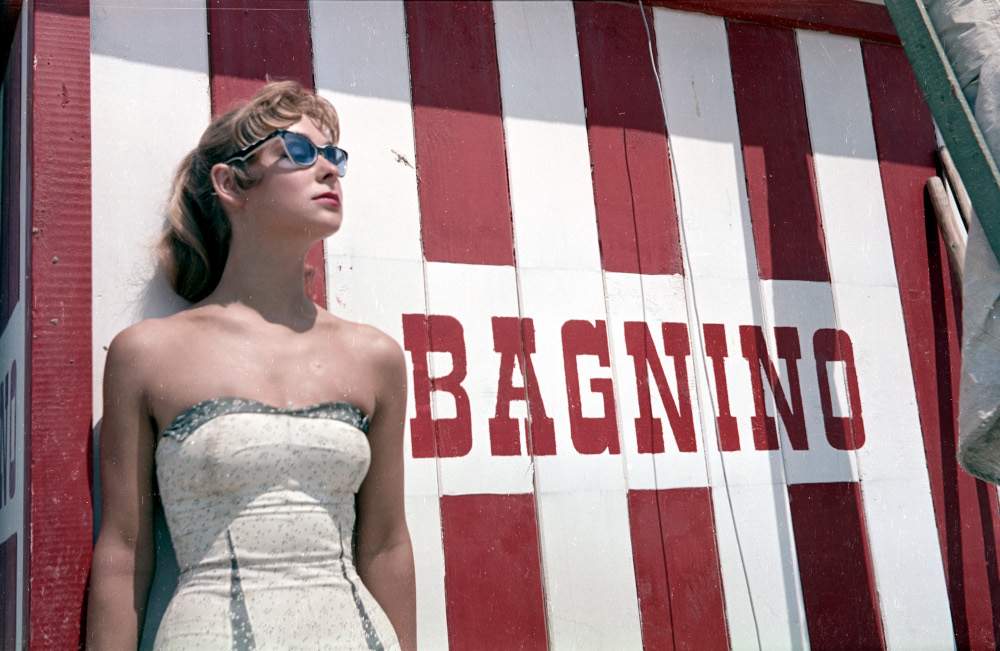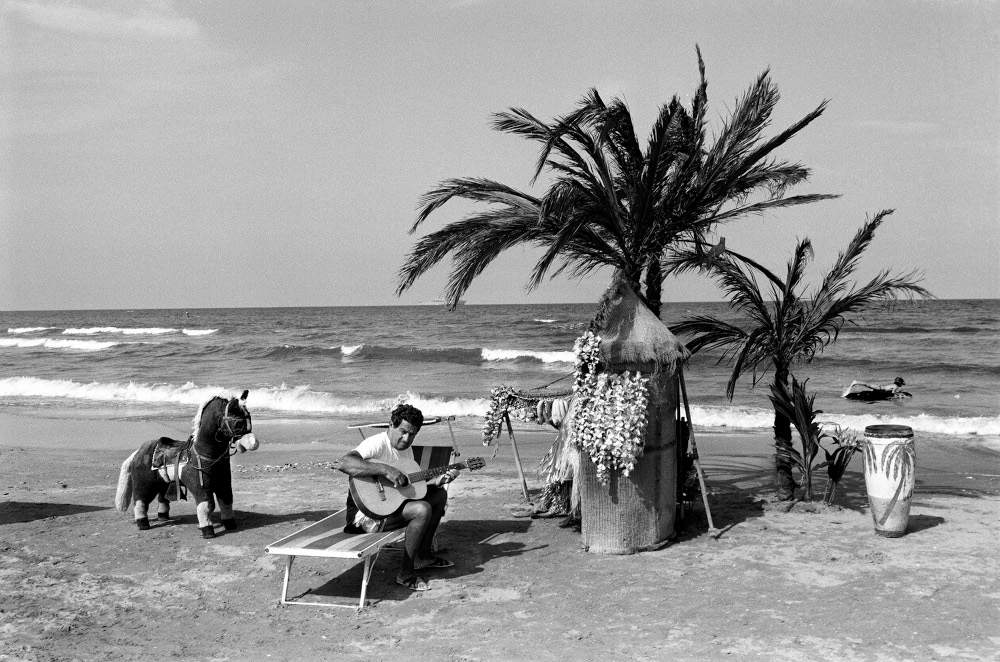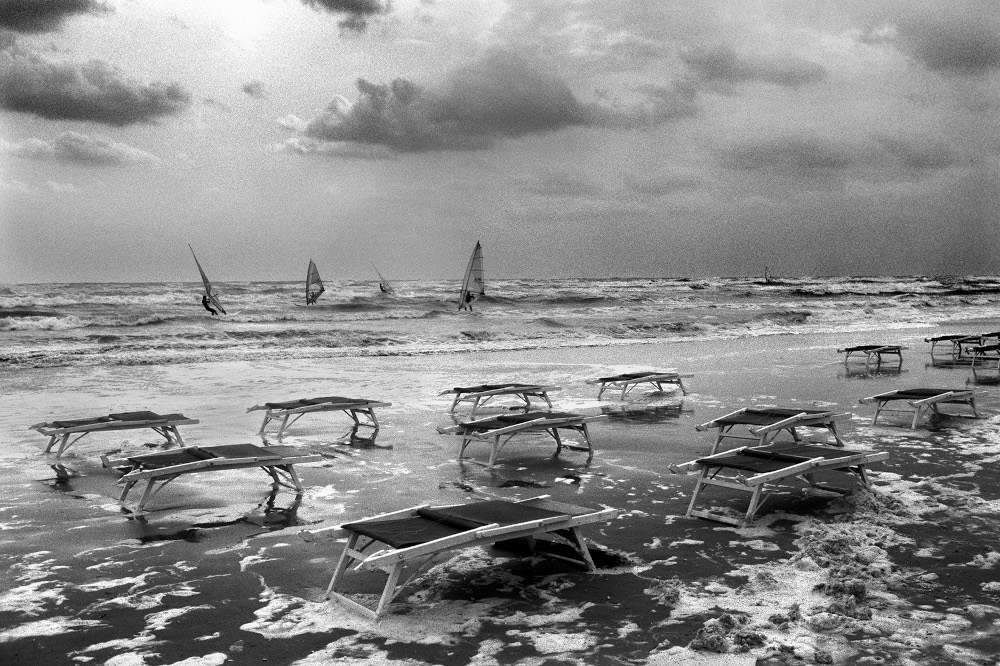In Rimini, the widespread photo exhibition Tutti al mare (1843-2023) is set up on the beach from July 1 to August 31, 2023. 180 Years on Vacation in Rimini. A seaside walk through 180 years of vacation history in Rimini, with nearly two hundred photographs and more than twenty posters, to accompany the public along almost two centuries of curiosities, places and customs from 1843, the year this wonderful story began, to the present day.
Walking from Bath 47 to Bath 100, one will encounter the one hundred placards intended to tell the story of the beach from its nineteenth-century beginnings to the present, passing through the years of the economic boom, when Rimini became the Capital of European beach tourism: more than two and a half kilometers of smiles, games, events, rituals and beach myths accompany the public along curiosities, places and practices that have partly remained unchanged for more than a century, and partly erased by time.
The itinerary consists of eight sections that recount the beginnings of beach life (It Begins!), the sea and its ways of setting sail (Dips and Splashes), the elegance of costumes and the sense of modesty (Chic&Chic), the waterfront and its events (Parades and Parades), beach organization and its architecture (Sheds and Roses), games (Shovels and Buckets), activities for the well-being of the body (Up Arms, Down Arms) and rituals with its characters (Types and Rituals). Accompanying the photographic apparatus are posters of past tourist promotions and some oddities.
The joking expression “This exhibition does not have a verse” returns one of the most original characters of this exhibit, where the width of the route (2.5 kilometers) did not allow for a chronological and sequential type of narrative. Hence the tale by eight autonomous stages of images evocative of certain themes that testify to persistence and recurrence over the 180 years considered: fashion with the evolution of costumes, the beach with its architecture and objects, games and pastimes, and beach types. Worth mentioning is the image from which it all began: the first notice promoting the opening of the first “Privileged Establishment of Maritime Baths in Rimini” (1843) and the first xylographic image of the Establishment taken from the advertisement for the 1847 season (both from the Gambetti collection of the Gambalunga Library).
Another turning point, the passage into public hands of the Bathing Establishment complex (1869) with the Kursaal that after a few years (it would be inaugurated on July 1, 1873) replaced the old wooden building (the photo of the Kursaal construction site in 1872 is significant) and the Hydrotherapy (inaugurated in 1876) that institutionalized the theme of marine cures as a source of health and well-being.
This was followed by the appearance of the villas on the lido (photo 1892) and in 1908 the opening of the Grand Hotel with the invention of the slogan Rimini the Ostend of Italy. The presence of posters constitutes a parallel path that shows the evolution of visual culture and the importance of communication through images and signs: from the first illustrated color poster in 1896 to the advertising posters of the seasons at the beginning of the century signed by Borgoni, Dudovich, Busi, Bianchi, to the campaigns of the last decades with the works of Gruau, Marco Morosini, Luca Giovagnoli, Eron up to the one designed by Marco Neri for the 2013 season.
And again, the rapid post-war restart in the late 1940s, the beach space filling up as the organization of beach services perfected. And the great crowd baths, unforgettable moments of collective euphoria, from the Corso dei Fiori (1957) to the Mototemporada (1970) to the Notte Rosa.
“We wanted to celebrate these 180 years of the life of the Rimini beach through an unusual and evocative exhibition that recounts the transformation of the beach from a natural resource that has always existed to an extraordinary tourism industry,” commented Rimini Mayor Jamil Sadegholvaad. “A physical place, but also an intangible and metaphorical landscape that since that first July 1843, the year the first bathing establishment was founded, passing through 1873 with the inauguration of the Kursaal, has established itself as the most important seaside resort in Europe, becoming the symbol of the seaside vacation and Rimini the most recognizable location of that ’ritual inversion’ that is the vacation. Special thanks go to ’Piacere spiaggia Rimini’ and to that precious treasure chest that holds the visual memory of the anthropological changes and aesthetic evolution of our city that is the photographic archive of the Gambalunga Library. Also through initiatives like these today Rimini, capable of always looking beyond, is a candidate for Italian Capital of Culture 2026.”
“After last year’s extraordinary success with the exhibition La Vita Dolce - Rimini di Pietra, Nuvole e Sale,” recalled Rimini South Lifeguard Cooperative President Mauro Vanni, “the first photographic exhibition organized on the seashore, the cultural program of the bathing season will be enriched in 2023 by a new photographic exhibition that not only celebrates these 180 years of history on the beach but also actively enters the beach to make history.”
For the most part, the images come from the municipal collections held at the Gambalunga Library, starting with the production of the Contessi photographers and the Tonini fund for nineteenth-century documentation. Images from the first decades of the twentieth century are drawn from the Battaglini, Freddi, Maioli and Rusticani collections, while from the collections of Enit and the Rimini-based Moretti studio comes documentation from the 1950s. From the APT and Minghini archives come images of the beach in the 1960s, 1970s and 1980s; from the Raggi Rimini Press archive come images for the next two decades. Rimini of the last two decades comes alive in the photos from the Municipality’s Press Office, mostly signed by Emilio Salvatori. Also generously contributing their own shots and materials were Giorgio Salvatori and Rimini Sparita.
Indispensable to the evocation of the visual imagery of Rimini as an international seaside destination are the posters and publicity posters from the seasons of the early 20th century signed by Borgoni, Dudovich, Busi, and Bianchi preserved in the Salce Collection in Treviso and the Bertarelli Civic Collection in Milan.
The exhibition is the result of the collaboration of the Municipality of Rimini, Biblioteca Gambalunga, Fellini Museum, Cooperativa Operatori di Spiaggia Rimini Sud, Piacere Spiaggia Rimini, in collaboration with the Department of Sciences for the Quality of Life - QuVi, University of Bologna Center for Advanced Studies in Tourism - CAST, University of Bologna, Romagna la Terra della Dolce Vita, Confartigianato.


Also, until Sept. 24, 2023, the Isotta Wing of Castel Sismondo in Rimini and the Sala Allende, in Palazzo Martuzzi, in Savignano sul Rubicone, are hosting Rimini Revisited - Beyond the Sea. Marco Pesaresi, curated by Mario Beltrambini and Jana Liskova, produced by the City of Savignano sul Rubicone and the Municipality of Rimini, with SI FEST, Fototeca Marco Pesaresi and Fellini Museum Rimini. The project is a winner of PAC2021 - Plan for Contemporary Art, promoted by the General Directorate for Contemporary Creativity of the Ministry of Culture. Twenty years later, the exhibition reproposes the journey through images of the Riviera through the shots of Rimini photographer Marco Pesaresi. Today, after twenty years, new images are added and displayed (the exhibition consists of 173 photographs in total), thanks to the considerable wealth of documents that the author left behind, contents that Marco Pesaresi repeatedly recounted and described in his texts and diaries. The result is a great fresco on the “Romagnolità” represented by the set of culture, traditions and landscapes that characterize the Romagna Riviera. Thus a new chapter is added to the great tale in images that Marco Pesaresi has built around the atmospheres, people, excesses and originality of his land and his city.
As part of a program to enhance the photographic fund of Marco Pesaresi kept in Savignano sul Rubicone, Rimini Revisited is intended to be a critical reinterpretation of the original project of the exhibition Rimini, which the reporter dedicated to his city and which was mounted posthumously in 2003. In its entirety, the exhibition has never been shown again although the photographs have become iconic of a certain way of photographing the Romagna Riviera. In the light of the insights gained from the study of the archives and in particular the discovery of the original menabout, elaborated by Marco Pesaresi, of the book that was born at the same time as the exhibition and published in 2003, which was also therefore posthumous, the revisitation retraces and reconstructs the continuous, tormented and obsessive research that led Marco Pesaresi to select, among the thousands of shots taken, the seventy-three photos exhibited and published then.
“The idea of a double path was fundamental from the beginning as we felt it was necessary to expand the boundaries of the project,” say curators Mario Beltrambini and Jana Liskova. “Exhibiting only the iconic and well-known photographs from the collection would have shed partial light on the amount of work Pesaresi performed, but we had the opportunity to study the project in its entirety. We selected from more than 25 thousand negatives the photographs that not only represent the daily life and unique atmosphere of the area but also Marco’s creative genius, sensitivity and technical prowess.”
“Twenty years after its staging,” commented Rimini Mayor Jamil Sadegholvaad, “one of the most significant photographic exhibitions that the city of Rimini has hosted in this beginning of the century is revived and revisited. A series of shots, alienating black and whites that have become symbolic of a certain way of perceiving and imagining the Riviera. This poignant and passionate homage of a son to his hometown, twenty years after Marco’s death and the publication of a catalog that has now become legendary, is a response to that manifold invitation to ’come beyond,’ to not stop at appearances and to ’go beyond’ that limit that would still like to imprison Rimini within a stereotype. An invitation that is the profound meaning of Rimini’s candidacy path as Capital of Culture 2026 and that is renewed through the creative intersection of its contradictions highlighted by this exhibition.”
“The Riviera and Romagna take shape, concrete and poetic at the same time, in Marco Pesaresi’s shots that, like Tondelli’s works, photograph a strongly characterized place and time, without being imprisoned by it,” said Savignano sul Rubicone Mayor Filippo Giovannini. “Marco conveys to us the carefree drama of an era solidly anchored in a deep, exciting, moving and at times poignant history; the life of this generous land, Romagna: strong, tolerant and uncompromising. A journey inside a storm of emotions.”
The exhibition can be visited at Rimini - Fellini Museum, Castel Sismondo, Piazza Malatesta, Tuesday through Sunday, 10 a.m. to 1 p.m. and 4 p.m. to 7 p.m.; every Wednesday and Friday in July and August, evening opening from 9 p.m. to 11 p.m. Closed on non-holiday Mondays. Sept. 1 to 24, Tuesday to Friday, 10 a.m. to 1 p.m. and 4 p.m. to 7 p.m., Saturday, Sunday and holidays 10 a.m. to 7 p.m. At the Savignano sul Rubicone location - Palazzo Martuzzi, Allende Hall, Corso Vendemini 18, Saturday and Sunday 10 a.m. to 1 p.m. and 4 p.m. to 7 p.m. Special openings during SI FEST 2023, in September. Free admission.



 |
| Two photo exhibitions in Rimini tell the story of the Riviera, a vacation destination, in pictures |
Warning: the translation into English of the original Italian article was created using automatic tools. We undertake to review all articles, but we do not guarantee the total absence of inaccuracies in the translation due to the program. You can find the original by clicking on the ITA button. If you find any mistake,please contact us.